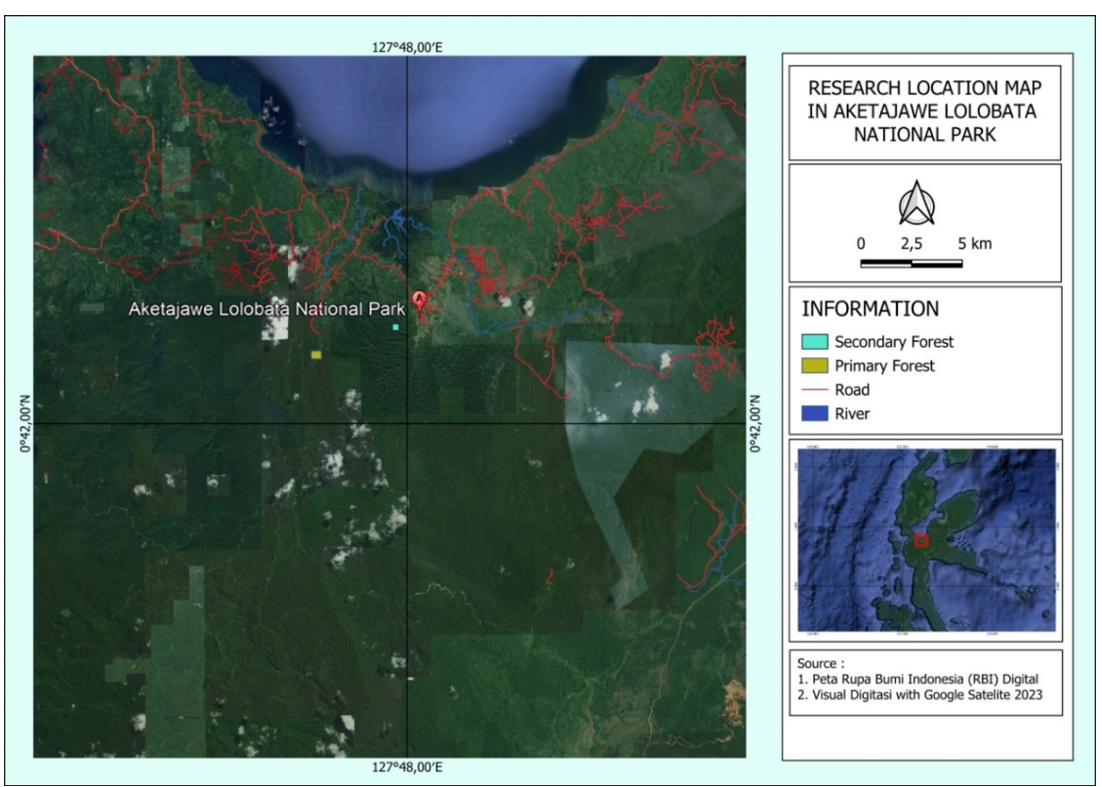Bird diversity in Aketajawe Lolobata National Park

Downloads
Research on richness and bird species diversity are important for conservation efforts in National Park. Currently, the Aketajawe Lolobata National Park (ALNP) is a habitat patch among industrial areas on Halmahera Island, so that it is important to carry out periodic bird inventories in the national park. Therefore, the need to study the current bird diversity and the status of bird species as a basis for future monitoring and implementation of appropriate conservation measures are important. Bird diversity research needs to be carried out because. Observation plots are placed at primary and secondary forest in Akejawi resort. The research was conducted on January to February 2022. Total observation point is 20 plots. The method was used by point count. The distance between the observation plot is 200 m and the radius of observation is 50 m. The observation were made in the morning (06.00-09.00 am). Repetition of observation on each habitat was carried out 10 times. Data were analyzed by using Shannon-Wiener Index Diversity. Based on findings, There were 345 individuals of 39 species from 19 families inhabited Akejawi Resort. Secondary forest had the highest diversity index when compared to primary forest. This study revealed that there were 9 birds originated from North Maluku and there were 15 species categorized as protected species. The latest data can provide opportunities for further research to reveal patterns of bird distribution and various protection measures due to the loss of forest areas around national parks.
Aketajawelolobata.org. (2023). Profil Taman Nasional Aketajawe Lolobata. Retrieved from https://aketajawelolobata.org/profil/. 29 May 2023.
Alikodra, H. (2002). Pengelolaan Satwa Liar. Fakultas Kehutanan IPB Bogor Pr, Bogor, Indonesia.
Bibby, C., Jones, M., Marsden S. (2000). Expedition Field Techniques Birds Surveys. Expedition Advisor Centre, London.
CITES (Convention on International Trade in Endangered Species of Wild Fauna and Flora). (2023). CITES-listed species. https://cites.org/eng. 29 May 2023.
Coates, B.J., Bishop, K.D. (2000). Panduan Lapang Burung-Burung di Kawasan Wallacea: Sulawesi, Maluku, dan Nusa Tenggara. BirdLife International-Indonesia Programme, Jakarta, Indonesia.
Clout, M., Hay, R. (1989). The importance of birds as browsers, pollinators and seed dispersers in the New Zealand forests. New Zealand Journal of Ecology, (12), 27-33.
Dahiya, P., Singh, D., Delu, V., Yodha, K., Dahiya, T., Kour, A., & Punia, N. (2022). Role of birds in agroecosystem: A review on agricultural and economic ornithology. The Pharma Innovation Journal, 11 (7), 2300-2314. www.thepharmajournal.com.
Dewi, Y., Mulyani, R.S., Santosa, Y. (2007). Keanekaragaman jenis burung di beberapa tipe habitat Taman Nasional Gunung Ciremai (skripsi). IPB University. Bogor.
Ekarelawan, O.J.J.H.H. (1990). Pola pembinaan habitat burung di kawasan pemukiman terutama di perkotaan. Media Konservasi, 3 (1),1-7.
Hadinoto., Mulyadi, A., Siregar, A.I. (2012). Kenakeragaman jenis burung di Hutan Kota Pekanbaru. J. Ilmu Lingkungan, 6 (1), 25-42. http://dx.doi.org/10.31258/jil.6.1.p.25-42.
IUCN Red List. (2022). The IUCN red list of threatened species. Retrieved from https://www.iucnredlist.org/. 29 May 2023.
Krebs, C.J. (1978). Ecology: The Experimental Analysis of Distribution and Abundance. Harper and Row Publishers, New York, USA.
Ludwig, J.A., & Reynolds, J.F. (1988). Statistical Ecology: A Primer Methods and Computing. John Wiley & Sons, New York, USA. p.200.
Magurran, A.E. (2004). Ecological Diversity and Its Measurement. Princenton University Pr, New Jersey, UK.
Mardiastuti, A. (2015). Ekologi Satwa Pada Lanskap Yang Didominasi Manusia. Fakultas Kehutanan IPB Bogor Pr, Bogor, Indonesia.
Mufti, F., Diniarsih, S., Untung, M., Setyono, J., Amna, M., & Setyobudi, N. (2011). Diversity of birds in Tepus Village of Gunung Kidul District of Yogyakarta. Proceeding ICBB (The International Conference on Bioscience and Technology) 1 (1), 102011. Retrieved from https://sunankalijaga.org/prosiding/index.php/icbb/article/view/174.
Nainggolan, F., Dewi, B., & Darmawan, A. (2019). Status konservasi burung: studi kasus di Hutan Cugung Kesatuan KPH lindung model Rajabasa Kecamatan Rajabasa Kabupaten Lampung Selatan. J.Sylva Lestari, 7 (2), 52-61. http://dx.doi.org/10.23960/jsl1752-61.
Ontario, J., Hernowo J.B., Haryanto., & Ekarelawan. (1991). Pola Pembinaan Habitat Burung di Kawasan Pemukiman Terutama di Perkotaan. Departemen Konservasi Sumberdaya Hutan dan Ekowisata Fakultas Kehutanan IPB University, Bogor, Indonesia.
Prasetyo, E., & Wulandari, R. (2021). Richness, diversity, and conservation status of bird species in Maron Beach, Semarang Indonesia. Quagga: Jurnal Pendidikan dan Biologi, 13 (1), 95-102. https://doi.org/10.25134/quagga.v13i1.3664.
Rohman, S.N., Mardiastuti, A., & Mulyani, Y.A. (2023). Bird diversity in several land use types in Boyolali, Central Java. IOP Conf. Ser.: Earth Environ. Sci. 1220 012009. https://doi.org/10.1088/1755-1315/1220/1/012009.
Soehartono, T., & Mardiastuti, A. (2003). Pelaksana Konvensi CITES di Indonesia. Japan International Cooperation Agency (JICA) Press, Jakarta, Indonesia.
Shah, S.B., Sharma, H.P. (2022). Bird diversity and factors affecting bird abundance at Dullu Municipality, Dailekh, Nepal. Biodiversitas, 23 (3), 1535-1545. https://doi.org/10.13057/biodiv/d230343.
Tamnge, F., Mulyani, Y.A., & Mardiastuti, A. (2013). Keanekaragaman jenis burung pada beberapa tipe habitat di Pulau Ternate. [thesis]. Fakultas Kehutanan IPB University, Bogor, Indonesia.
Tu, H.M., Fan, M.W., & Ko, J.C.J. (2020). Different habitat types effect bird richness and evenness. Sci Rep 10, 1221. https://doi.org/10.1038/s41598-020-58202-4.
Warmetan, H., Kesaulija, F.F., & Sadsoeitoeboen, B.M.G. (2015). Keragaman dan Status Konservasi Jneis Burung Air di Danau Yamor. Jurnal Kehutanan Papuasia, 1 (2), 99-107. https://doi.org/10.46703/jurnalpapuasia.Vol1.Iss2.35.




